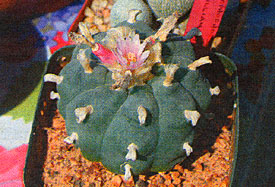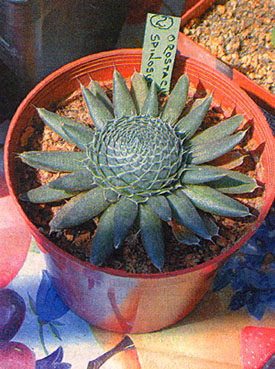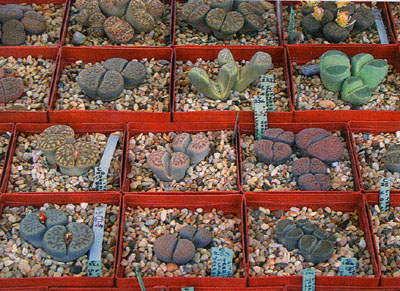 |
||
|
A Passion for Prickles
|
||
|
By Jennifer Gay
Athens News |
 Lopophora williamsii--Peyote Cactus |
|
| On a southern Athenian apartment verandah, measuring not much more than 2m x 121m, Kimon Mangos keeps a huge collection of succulents. Mangos, who is president of the Hellenic Cactus and Succulent Society (EEKAP), has, over a number of years, put together a diverse and rich collection of this fascinating plant group. He first became interested quite by chance--his wife brought a cactus home, and he began to take care of it. He was intrigued by its form and survival techniques, and soon he was collecting other specimens. Mangos now has over one thousand different species on his balcony, which represent around 10 percent of the global number of succulents. They are kept side by side in pots of varying sizes and tended with loving care by their owner. Some need morning sun and afternoon shade, while for others it’s the reverse and duly the plants are moved around the balcony according to their needs. |
||
| The collection contains all manner of succulents, from living stones (Lithops), to the bold columnar magnificence of Cereus and Euphorbia, to the flower like forms of Aeontum, Aloe, Echeveria or the rounded Mammillaria and Rebutia cacti. Viewed alone, succulents become minimalist sculpture; grouped together they mirror vast desert scenery. Leaf and stem colors range from the deep green zebra stripes of Haworthia attenuata to the lavender-tinted leaves of striking orange-blossomed Echeveria peacockii. Many succulents produce startling flowers in saturated hues, and there were astonishing flowers of exquisite beauty on Mango’s balcony. |
 Orostachys spinosus |
|
| The umbrella term succulent is used to describe any of the many different kinds of plants with exceptional water-retaining properties. They have modified structures that enable them to store water and withstand drought for long periods. Special cells in their leaves, branches, stems, or roots collect and hold water, releasing it into the plant when needed. Succulents grow in almost all parts of the world with the exception of Antartica, but some of the richest regions are South Africa, Madagascar and North and South America. There are some succulents growing native in Greece, notably Stonecrop (Sedum) and Houseleek (Sempervirens), but most of the larger ones growing here were introduced. Cacti, on the other hand, are a distinctive group which evolved exclusively in the Americas, occupying a wide range of arid and moderately humid habitats from Canada to Patagonia. If Mangos’ collection shows anything it is that succulents are incredibly versatile and can be grown in the smallest of spaces. If you have absolutely no outside room, the tiny ones are perfect for a windowsill display. Small rock–colored cacti with wart-like markings (Ariocarpus) are good for restricted positions, as are Turbinocarpus, tiny barrel cacti with soft, bent spines and white or pink flowers and Astrophytum asterias, with its low rounded spineless body divided into eight flat ribs with small white flecks. Serious succulent collection warrants ethical considerations, no-one is more aware than Mangos about the problems of succulent smugglers. He advocates great care when purchasing succulents. Smugglers are threatening many species in North America deserts, notably the Chihuahua; one of the worlds most diverse but threatened arid regions and home to many rare endemics. According to a report released by TRAFFIC last year (the wildlife trade monitoring network of the World Wildlife Fund and the World Conservation Union), 200 cacti species, including the living rock, eagle claw, Texas barrel and hedgehog cactus, could be at risk if measures aren’t taken to regulate harvesting in and near protected areas. Co-author of the report, Christopher S Robbins says: “If we don’t reduce the demand…we run the risk of destabilizing populations and losing species”. Desert dwellers from hummingbirds to mountain lions rely on desert plants for food or shelter and removing cactus can be as disruptive to the ecosystem as clear-cutting a forest. Despite their importance in the ecosystem cacti have been commercially harvested from this region at least since 1940s. The demand for cacti has increased in recent years along with other large desert adapted plants such as Yuccas. Alongside grazing, demand from the multi-million dollar industry that has grown up around cactus collection are the two biggest threats to habitats. Europe and Japan have recently become common destinations for smuggled plants and seeds, with the UK, Germany and Sweden topping the demand list. Over-zealous collectors have been known to remove dozens, even hundreds of species at a time; such harvesting can severely deplete wild populations that are already hampered by restricted ranges of habitat and low levels of seed production. Says Mangos: “You need to ensure that the succulents you buy come from a reputable source.” If you find a mature cactus with a cheap price tag you can almost guarantee it’s gone through the back door. |
||
Although commercial cultivation of cactus is well-established, the demand is large enough to absorb specimens from disreputable sources. Plants culled from the wild increase profit margins for traders as they don’t require time-consuming and expensive greenhouse cultivation. Mangos explains, “A reputable source should be CITES certified, (Convention on International Trade in Endangered Species) and able to prove that the seeds and cuttings were legitimately obtained and the plants were not stolen from the wild. The plants should have been propagated and grown in nursery conditions. In reality, most Greek nurseries probably buy ready-propagated plants from the middle man nursery in Germany or the UK, and don’t trade at source, so the problem is indirect here”. |
||
|
Collectors have, however, had positive effects as well as negative ones. The survival of Mammillaria scheinvariana is an interesting case in point: the only place it grew in the world was the site of a proposed dam project in Mexico. As flooding levels rose, the plants were rapidly disappearing. Succulent enthusiasts alerted the government to the fact that the plants would become extinct if the flooding continued. Eventually the government gave permission for the plants to be relocated, but it was largely through the efforts of individual cactus lovers that the plants were rescued. Looking at Mangos’ well-tended collection, it is easy to see how succulents can become a passion. Though some are inevitably more attractive than others, each plant is intriguing in its quiet ability to endure the harshest conditions, and never more so when they magically send out their vivid but almost delicate-looking blooms. |
||
 Mangos' collection of Living Stones (Lithops and Conophytum) |
||
For more details about cacti and succulents, contact The Hellenic Cactus and Succulent Society (EEKAP), Attention Kimon Mangos, 27 Dimokritou St, Argyroupoli, 16451 Athens Tel: 210-994-3319. [From the US: 011-30-210-994-3319] Email: mangoski@otenet.gr HCS readers can view other excellent articles of the Athens News in our extensive, permanent archives at the URL http://www.helleniccomserve.com./contents.html
All articles of Athens News appearing on HCS have been reprinted with permission. We invite readers to view other articles on gardening and the outdoors at our extensive, permanent archives at http://www.helleniccomserve.com/contents.html# Food,%20Recipes%20and%20Garden |
||
 |
||
|
2000 © Hellenic Communication Service, L.L.C. All Rights Reserved. http://www.HellenicComServe.com |
||
